While winter temperatures usually drop with the arrival of northeastern winds that sweep across western Taiwan, people may have also noticed worsened air quality, or even experienced mild symptoms of eye irritation, sneezing or coughing in the past months.
The Environmental Protection Administration’s (EPA) Department of Environmental Monitoring and Information Management Director Chu Yu-chi (朱雨其) said the department’s data showed that there have been seven haze and dust storms since December last year.
According to data from the EPA’s air quality monitoring network, the concentration levels of particles under 2.5 micrometers in diameter (PM2.5) detected at nearly all of the nation’s 76 monitoring stations rose drastically as air pollutants were brought in from China by strong winds.
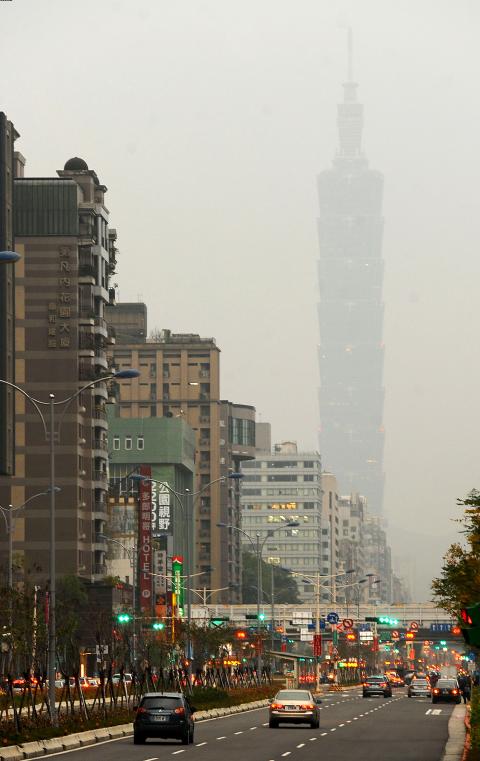
Photo: Wang Min-wei, Taipei Times
On Dec. 10 last year, PM2.5 levels detected at 72 stations surpassed 80 micrograms per cubic meter (μg/m3).
The nation’s daily average and annual average PM2.5 concentration standards are set at 35μg/m3 and 15μg/m3 respectively.
When obscured by cross-border haze, the pollution standards index (PSI) readings — which are based on the highest concentration value of five major air pollutants PM10 (particulate matter 10 micrometers or less in diameter), sulfur dioxide, nitrogen dioxide, carbon monoxide and ground-level ozone — at most stations reached unhealthy levels and a few in central and southern Taiwan reached hazardous levels.
The EPA’s data also showed that the nation’s average PM10 level of 64μg/m3 and average maximum readings of 256μg/m3 in December last year were higher than those of the same month in the previous two years — 53μg/m3 and 163μg/m3 in 2012, and 50μg/m3 and 150μg/m3 in 2011.
Currently, the standards for daily average and annual average PM10 concentration levels in Taiwan are set at 125μg/m3 and 65μg/m3 respectively.
“The two main factors considered when determining whether the air pollutants are from cross-border pollution are recent weather phenomena and monitoring data on the air pollutant levels in China’s major cities,” Chu said, adding that “generally speaking, these situations [of worsened air quality caused by air pollutants from China] occur every winter.”
However, he said the department has noticed that the frequency and concentration of elevated pollution levels detected this year have been slightly higher than previous years.
Air pollutant levels detected at stations located in Yunlin, Chiayi and Greater Tainan often topped the list of stations, the EPA department’s Deputy Director Chang Shuenn-chin (張順欽) said, adding that this was because fugitive dust — particles suspended in the air by wind action and human activities — at riverbanks during the low-flow season of winter are swept up by the strong northeastern winds.
“The fugitive dust at Jhuoshuei River (濁水溪) during the northeastern monsoon season is not a new phenomenon,” he said.
He added that the frequency and scale of Choshui River fugitive dust have increased in recent years, clearly worsening air quality in central and southern areas.
Analyzing the readings from various agencies, the department discovered that when strong earthquakes above magnitude 5, such as the magnitude 7.3 921 Earthquake in 1999, shake loose soil on upstream slope areas, which is then washed downstream by torrential rains during the summer, land collapse and mud slides are likely, which creates dust on riverbanks, Chang said.
“When wind speeds exceed 3 meters per second, gusts of fugitive dust with PM10 concentration levels above 250μg/m3 are likely to occur,” he said.
The EPA’s monitoring data showed that the maximum reading of PM10 concentration levels soared up to 2,532μg/m3 in Yunlin County’s Lunbei Township (崙背) and 1,793μg/m3 at Chiayi County’s Puzih City (朴子) in 2009, and to 582μg/m3 at Puzih and 497μg/m3 at Lunbei last year.
Chang said that the causes are closely related to heavy rainfall and mudslides during Typhoon Morakot in 2009 and a magnitude 6.3 earthquake that occurred in Nantou County in June last year.
Civic groups and lawmakers have repeatedly called for stricter standards and solutions amid increased exposure to high levels of PM2.5 that are suggested in scientific studies to be linked with numerous health problems — including asthma, bronchitis, acute and chronic respiratory symptoms, and even premature deaths — and PM10 in recent years.
The EPA began following Japan’s move to issue warnings when the PM2.5 level reaches more than 80μg/m3, as the elderly, young children, and people with lung, throat, nose or respiratory problems are more at risk when daily average PM2.5 concentration levels exceed 70μg/m3.
During a committee meeting earlier this month at the legislature in Taipei, the EPA agreed to formulate the Air Quality Index (AQI) that will further include PM2.5 readings and an 8-hour average of ozone.
However, Taiwan Healthy Air Action Alliance founder Yeh Guang-peng (葉光芃) said that although the government is moving in the right direction, “its pace is always too slow. It only agrees [to take action] when we [civic groups] push it.”
Government data from Switzerland showed that an estimated 3,700 people die each year from causes related to air pollution, he said.
“Considering that Switzerland’s average PM10 concentration level is about 20μg/m3, the question is how many people will be affected when the levels reach 70μg/m3 in Taiwan,” Yeh added.
Yeh said that while Japan and South Korea are beginning to work together to combat air pollution, the Taiwanese government has not done enough to combat pollution and should communicate with China on how to control dust storms and haze.
He added that air pollutant levels should not be blamed solely on cross-border transfer or extreme weather, because long-term collection and comparison of air quality data from Taiwan and other countries showed that Taiwan’s concentration levels of PM2.5 and PM10 were often higher than those of many other countries.
Yeh said that although he was aware that it would not be easy to reach the ideal levels immediately, civic groups felt that the government has not been sincere enough in its efforts to push for stricter regulations and in planning solutions to improve air quality.
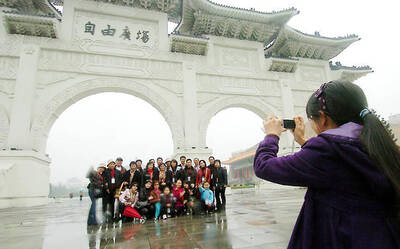
NUMBERS IMBALANCE: More than 4 million Taiwanese have visited China this year, while only about half a million Chinese have visited here Beijing has yet to respond to Taiwan’s requests for negotiation over matters related to the recovery of cross-strait tourism, the Tourism Administration said yesterday. Taiwan’s tourism authority issued the statement after Chinese-language daily the China Times reported yesterday that the government’s policy of banning group tours to China does not stop Taiwanese from visiting the country. As of October, more than 4.2 million had traveled to China this year, exceeding last year. Beijing estimated the number of Taiwanese tourists in China could reach 4.5 million this year. By contrast, only 500,000 Chinese tourists are expected in Taiwan, the report said. The report
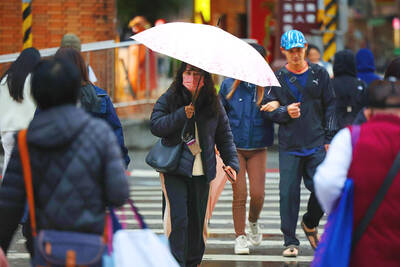
Temperatures are forecast to drop steadily as a continental cold air mass moves across Taiwan, with some areas also likely to see heavy rainfall, the Central Weather Administration (CWA) said. From today through early tomorrow, a cold air mass would keep temperatures low across central and northern Taiwan, and the eastern half of Taiwan proper, with isolated brief showers forecast along Keelung’s north coast, Taipei and New Taipei City’s mountainous areas and eastern Taiwan, it said. Lows of 11°C to 15°C are forecast in central and northern Taiwan, Yilan County, and the outlying Kinmen and Lienchiang (Matsu) counties, and 14°C to 17°C
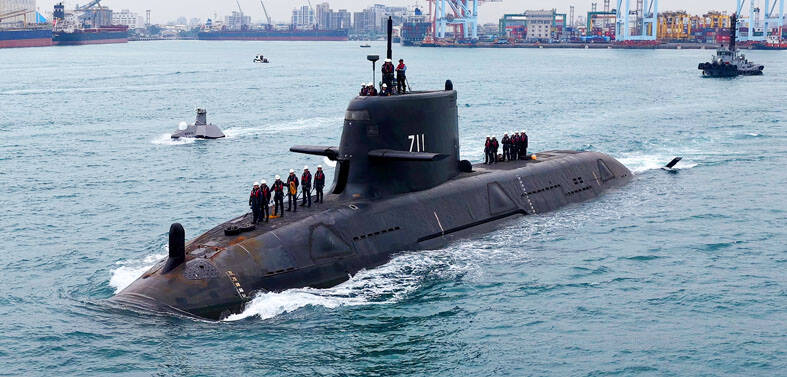
STEERING FAILURE: The first boat of its class is experiencing teething issues as it readies for acceptance by the navy, according to a recent story about rudder failure The Hai Kun (海鯤), the nation’s first locally built submarine, allegedly suffered a total failure of stern hydraulic systems during the second round of sea acceptance trials on June 26, and sailors were forced to manually operate the X-rudder to turn the submarine and return to port, news Web site Mirror Daily reported yesterday. The report said that tugboats following the Hai Kun assisted the submarine in avoiding collisions with other ships due to the X-rudder malfunctioning. At the time of the report, the submarine had completed its trials and was scheduled to begin diving and surfacing tests in shallow areas. The X-rudder,
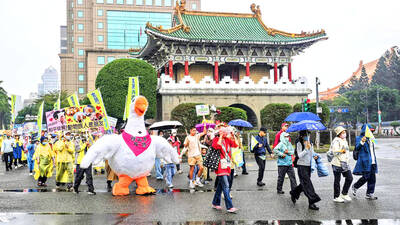
DEMAND: The government should enact regulations in line with Austria and Germany to incorporate vegan nutrition into school meals, an advocate said More than 1,000 people yesterday marched in Taipei to promote veganism, calling for legislation to incorporate vegan diets into school lunches and the national net zero emissions program. Participants gathered on Ketagalan Boulevard in front of the Presidential Office Building for the march, which was organized by the Vegan Action Network (VAN). Former ambassador to Chad Chiu Chung-jen (邱仲仁), actor Yankee Yang (楊子儀) and actress Cindy Lien (連俞涵) attended the event. VAN member Marianne Chao (趙梅君) said that the campaign aimed to urge the government to promote vegan diets across schools and government agencies via legislation and national policies, which would help build